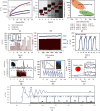Gecko-Inspired Slant Hierarchical Microstructure-Based Ultrasensitive Iontronic Pressure Sensor for Intelligent Interaction
- PMID: 35935142
- PMCID: PMC9275085
- DOI: 10.34133/2022/9852138
Gecko-Inspired Slant Hierarchical Microstructure-Based Ultrasensitive Iontronic Pressure Sensor for Intelligent Interaction
Abstract
Highly sensitive flexible pressure sensors play an important role to ensure the safety and friendliness during the human-robot interaction process. Microengineering the active layer has been shown to improve performance of pressure sensors. However, the current structural strategy almost relying on axial compression deformation suffers structural stiffening, and together with the limited area growth efficiency of conformal interface, essentially limiting the maximum sensitivity. Here, inspired by the interface contact behavior of gecko's feet, we design a slant hierarchical microstructure to act as an electrode contacting with an ionic gel layer, fundamentally eliminating the pressure resistance and maximizing functional interface expansion to achieving ultrasensitive sensitivity. Such a structuring strategy dramatically improves the relative capacitance change both in the low- and high-pressure region, thereby boosting the sensitivity up to 36000 kPa-1 and effective measurement range up to 300 kPa. To verify the advantages of high sensitivity, the sensor is integrated with a soft magnetic robot to demonstrate a biomimetic Venus flytrap. The ability to perceive weak stimuli allows the sensor to be used as a sensory and feedback window, realizing the capture of small live insects and the transportation of fragile objects.
Copyright © 2022 Yongsong Luo et al.
Conflict of interest statement
The authors declare that there is no conflict of interest regarding the publication of this article.
Figures




Similar articles
-
Iontronic pressure sensor with high sensitivity and linear response over a wide pressure range based on soft micropillared electrodes.Sci Bull (Beijing). 2021 Jun 15;66(11):1091-1100. doi: 10.1016/j.scib.2021.02.019. Epub 2021 Feb 9. Sci Bull (Beijing). 2021. PMID: 36654343
-
Hierarchical Synergetic Strategy for Iontronic Pressure Sensors with High Sensitivity and Broad Linearity Range.ACS Sens. 2025 Mar 28;10(3):2030-2037. doi: 10.1021/acssensors.4c03238. Epub 2025 Mar 6. ACS Sens. 2025. PMID: 40047812
-
Non-equilibrium compression achieving high sensitivity and linearity for iontronic pressure sensors.Sci Bull (Beijing). 2024 Jul 30;69(14):2221-2230. doi: 10.1016/j.scib.2024.05.001. Epub 2024 May 11. Sci Bull (Beijing). 2024. PMID: 38782658
-
Materials, Structures, and Functions for Flexible and Stretchable Biomimetic Sensors.Acc Chem Res. 2019 Feb 19;52(2):288-296. doi: 10.1021/acs.accounts.8b00497. Epub 2019 Jan 17. Acc Chem Res. 2019. PMID: 30653299 Review.
-
Flexible Electronics toward Wearable Sensing.Acc Chem Res. 2019 Mar 19;52(3):523-533. doi: 10.1021/acs.accounts.8b00500. Epub 2019 Feb 15. Acc Chem Res. 2019. PMID: 30767497 Review.
Cited by
-
Ultrafast piezocapacitive soft pressure sensors with over 10 kHz bandwidth via bonded microstructured interfaces.Nat Commun. 2024 Apr 8;15(1):3048. doi: 10.1038/s41467-024-47408-z. Nat Commun. 2024. PMID: 38589497 Free PMC article.
-
Advanced Morphological and Material Engineering for High-Performance Interfacial Iontronic Pressure Sensors.Adv Sci (Weinh). 2025 Feb;12(8):e2413141. doi: 10.1002/advs.202413141. Epub 2025 Jan 22. Adv Sci (Weinh). 2025. PMID: 39840613 Free PMC article. Review.
-
Electric-Field-Driven Generative Nanoimprinting for Tilted Metasurface Nanostructures.Nanomicro Lett. 2025 Jul 28;18(1):12. doi: 10.1007/s40820-025-01857-3. Nanomicro Lett. 2025. PMID: 40719967 Free PMC article.
-
Haptic Sensing and Feedback Techniques toward Virtual Reality.Research (Wash D C). 2024 Mar 23;7:0333. doi: 10.34133/research.0333. eCollection 2024. Research (Wash D C). 2024. PMID: 38533183 Free PMC article. Review.
-
Boron nitride-enabled printing of a highly sensitive and flexible iontronic pressure sensing system for spatial mapping.Microsyst Nanoeng. 2023 May 26;9:68. doi: 10.1038/s41378-023-00543-x. eCollection 2023. Microsyst Nanoeng. 2023. PMID: 37251710 Free PMC article.
References
LinkOut - more resources
Full Text Sources

